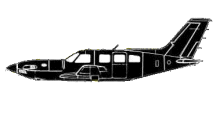
ASN Wikibase Occurrence # 288931
This information is added by users of ASN. Neither ASN nor the Flight Safety Foundation are responsible for the completeness or correctness of this information.
If you feel this information is incomplete or incorrect, you can submit corrected information.
| Date: | Friday 19 August 2011 |
| Time: | 14:55 LT |
| Type: |  Piper PA-46-500TP Meridian |
| Owner/operator: | |
| Registration: | N133SR |
| MSN: | 4697114 |
| Total airframe hrs: | 1916 hours |
| Engine model: | Pratt & Whitney PT6A-42A |
| Fatalities: | Fatalities: 0 / Occupants: 2 |
| Aircraft damage: | Substantial |
| Category: | Accident |
| Location: | Manasses, Virginia -
 United States of America United States of America
|
| Phase: | Landing |
| Nature: | Private |
| Departure airport: | Atlanta-Cobb County-Mc Collum Field, GA (KRYY) |
| Manassas Regional-Harry P. Davis Field, VA (MNZ/KHEF) | |
| Investigating agency: | NTSB |
| Confidence Rating: |
The airplane landed on runway 16 with the wind from 220 degrees true at 4 knots. The pilot reported that he landed on the centerline and kept the nosewheel off the runway for 3 to 4 seconds. The nosewheel then touched down, and 3 to 4 seconds later, the airplane started veering to the left. The pilot first added some right rudder, and because the heading did not correct, he added more right rudder. When the heading still wouldn't correct, he "jumped" on the brakes and put the propeller into Beta and reverse. The airplane subsequently veered off the left side of the runway and into the median, where the nose landing gear separated from the airframe. Skid marks on the runway and in the grass were consistent with the pilot's recollection of the accident.
The airplane had completed an annual inspection 20 days earlier, in which the nosewheel bearings were replaced. Postflight examination of the nosewheel revealed that it rotated freely and that the bearings appeared pristine with new bearing grease. The pilot also noted that he had not checked the tire pressures since the annual inspection, but had visually inspected the tires during preflight inspections.
The airframe manufacturer determined that certain anomalies can reduce optimum steering capability in the make and model of the airplane, such as an underinflated nose landing gear tire, improper nose landing gear rake angle, excessive clearance between the nose landing gear steering arm and nose gear rollers, and low rudder cable tension. The airplane was examined 6 days after the accident, and the nosewheel tire pressure indicated 55 psi; a fully inflated tire should indicate 70 psi. Tire manufacturers estimate that up to a 5 percent reduction of tire pressure per day is normal, and even after continued losses after a period of time, an underinflated tire could still appear to be normally inflated.
Given that the pilot had not checked the tire pressure in the 20 days before the accident, the nosewheel tire was likely underinflated (due to normal air loss) at the time of the accident; however, the tire pressure at the time of the accident could not be determined, and it could not be determined if it could have contributed to the loss of directional control. In addition, the three other detrimental effects on steering stability could not be measured because the nose landing gear separated from the airframe during the accident. Because of the benign landing conditions and the pilot's aeronautical experience, it is unlikely that the loss of directional control resulted from his piloting skills; it was more likely that it resulted from one or a combination of the four detrimental effects on steering stability.
.
Probable Cause: An undetermined nose landing gear steering anomaly or anomalies, which resulted in the pilot's inability to maintain directional control of the airplane during the landing rollout. The damage to the nose landing gear precluded a determination of the cause of the nose landing gear anomaly.
Accident investigation:
 |
|
Sources:
NTSB ERA11LA466
Location
Revision history:
| Date/time | Contributor | Updates |
|---|---|---|
| 05-Oct-2022 07:51 | ASN Update Bot | Added |
Corrections or additions? ... Edit this accident description
The Aviation Safety Network is an exclusive service provided by:


 ©2024 Flight Safety Foundation
©2024 Flight Safety Foundation